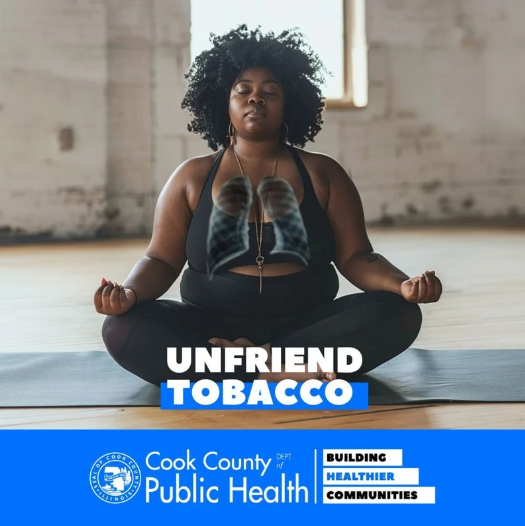By Alfreda Holloway-Beth and Christopher Smith
In recognition of Lung Cancer Awareness Month, Cook County Department of Public Health’s Epidemiology Unit recently conducted an analysis of lung cancer mortality and tobacco-related emergency department visits in suburban Cook County. It’s important to note that tobacco use remains the leading cause of preventable disease and death in the United States.
Although lung cancer mortality has declined overall, we continue to see tobacco related disparities. These disparities do not reflect individual choices. They reflect long-standing inequities in access to quality health care, early detection, and treatment.
The Suburban Cook County Health Atlas looks at tobacco-related health outcomes through three indicators: lung cancer mortality, tobacco-related emergency department (ED) visits, and adult and youth vaping behavior. Together, these data illuminate both the long-term effects and behaviors of tobacco use across populations in suburban Cook County.
Lung Cancer Mortality
Lung cancer mortality has declined steadily from 2010 to 2023, falling from about 44 deaths per 100,000 residents in 2010 to 26 per 100,000 in 2023. What this means is lung cancer deaths in suburban Cook County have nearly been cut in half since 2010, dropping from the equivalent of 44 people out of a town of 100,000 to about 26 today. This improvement reflects broader public health progress in tobacco control, early detection, and treatment.
Although lung and bronchus cancer mortality has declined across all racial and ethnic groups in suburban cook county over the past decade, serious disparities persist.
Black residents consistently experience the highest mortality, though their rates have fallen from over 56 per 10,000 in 2010 to the mid 30’s by 2020, followed by a recent uptick in 2023. Rates among white residents and the overall population show steady declines, reaching their lowest levels between 2019 and 2021 before inching upward again. Hispanic and Asian residents continue to experience the lowest mortality, though both groups show small fluctuations rather than a uniform downward trend. The data shows progress, but it also underscores the need for sustained efforts to close the persistent racial gaps in cancer outcomes.
Tobacco Related Emergency Department Visits
Tobacco-related emergency department visit rates in suburban Cook County show a clear and persistent racial gap, with Black residents experiencing dramatically higher rates than every other group. Their age-adjusted rates peaked above 1,400 per 100,000 in 2020 and 2021 and, although they declined sharply by 2023, they rose again in 2024 to nearly 200 per 100,000, which is still above the levels observed in other populations. The overall population, along with White, Hispanic and Asian residents shows far lower and more stable rates with only modest year to year fluctuations.
Although recent declines are encouraging, the scale of disparity signals an urgent need for tailored tobacco prevention, cessation support and structural interventions that meet the needs of the most burdened residents.
E-Cigarette Use
Data from the Suburban Cook County Health Atlas show that e-cigarette use remains a public health concern but is trending downward overall. Among adults, about 6.6% report current e-cigarette use, with the highest rate among Hispanic/Latino adults 9.4% and lower rates among White 5.9%, Asian 5.2%, and Black 4.3% residents. Youth vaping is more common but has declined sharply, with 17% of high-school students reporting past-month use in 2020 compared with 8.5% in 2024.
Despite this progress, racial and ethnic disparities persist, with Black and White students reporting slightly higher use than Hispanic/Latino and Asian peers. Together, these data suggest continued progress in tobacco control alongside ongoing needs for prevention and cessation efforts to reach both youth and adult audiences.
In Summary
While there has been some advancement in tobacco prevention and control efforts, tobacco-related disparities persist. These disparities do not reflect individual choices. They reflect long-standing inequities in access to quality health care, early detection, and treatment. Communities of color, particularly Black residents, have faced decades of underinvestment, limited access to preventive services, higher exposure to predatory tobacco marketing, and environmental stressors that increase their risk of morbidity and mortality. These inequities require a comprehensive approach that includes equitable access to lung cancer screening and treatment, access to evidence-based tobacco cessation resources, and tobacco prevention education for those at higher risk.
Cook County Department of Public Health’s Tobacco Prevention and Control Program (TPCP) works with community partners to strengthen state, county, and municipal tobacco prevention and control policies to eliminate exposure to secondhand smoke, prevent youth from starting to smoke and vape, promote quitting smoking, and identify and reduce tobacco-related disparities in suburban Cook County. To learn more about the program and for links to free quitting resources, visit Unfriendtobacco.com.
Resources
Related insights: See the data on the Health Atlas:
Lung Cancer Mortality Rate in Suburban Cook County by Race and Ethnicity, 2010-2023
Tobacco-Related ED visitation Rate in Suburban Cook County by Race and Ethnicity, 2016-2024
Related Resources:
Look up Data: Link to the Cook County Health Atlas Home
Get Help Quitting Smoking/ Unfriend Tobacco Unfriend Tobacco – Cook County Department of Public Health


